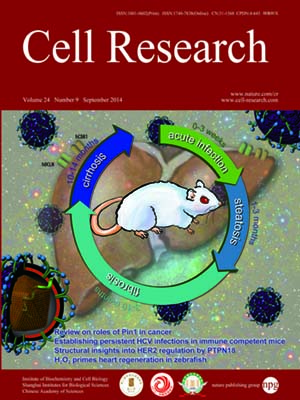
Volume 24, No 9, Sep 2014
ISSN: 1001-0602
EISSN: 1748-7838 2018
impact factor 17.848*
(Clarivate Analytics, 2019)
Volume 24 Issue 9, September 2014: 1146-1149 | Open Access
LETTERS TO THE EDITOR
Structure and domain organization of Drosophila Tudor
Ren Ren1,2, Haiping Liu1,5, Wenjia Wang3, Mingzhu Wang1, Na Yang1, Yu-hui Dong3, Weimin Gong1, Ruth Lehmann4 and Rui-Ming Xu1
1National Laboratory of Biomacromolecules, National Center for Protein Science (Beijing), Institute of Biophysics, Chinese Academy of Sciences, Beijing 100101, China
2University of Chinese Academy of Sciences, Beijing 100049, China
3Beijing Synchrotron Radiation Facility, Institute of High Energy Physics, Chinese Academy of Sciences, Beijing 100049, China
4Skirball Institute of Biomolecular Medicine, HHMI, New York University School of Medicine, 540 First Avenue, New York, NY 10016, USA
5Current address: Tianjin Institute of Industrial Biology, Chinese Academy of Sciences, Tianjin 300308, China
Correspondence: Rui-Ming Xu,(rmxu@sun5.ibp.ac.cn)
Drosophila tudor is a maternal effect gene required for germ cell formation and abdominal segmentation during oogenesis1,2. It encodes a large protein, Tudor (Tud), of 2 515 amino acids, containing 11 copies of a ~60-residue sequence motif, termed the tudor domain. Tudor domains are best characterized by their methyllysine and methylarginine binding abilities3,4,5. Biochemically, Tud interacts with Aubergine (Aub), a Piwi family protein, in a manner dependent on symmetrically dimethylated arginine (sDMA) residues located at the N-terminal end of Aub6,7,8. The sDMA-dependent interaction between Tud and Aub is part of a broad range of phenomena involving tudor domain and Piwi family proteins, in species ranging from fruit flies to mammals3. We and others have shown previously that domains 7-11 of Tud (Tud7-11) were necessary and sufficient for germ cell formation and interaction with arginine-methylated Aub9,10,11. The structure of Tud11 in complex with sDMA-Aub peptides, together with the structure of human SND1 (TDRD11) bound to sDMA peptides from PIWIL1, uncovered the composition of the sDMA-binding pocket, which consists of a cage of four aromatic residues and an asparagine10,12.
10.1038/cr.2014.63
FULL TEXT | PDF
Browse 2290


